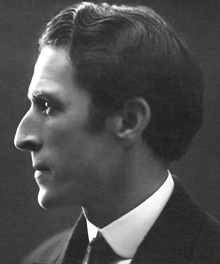Paul Follot
| Paul Follot | |
|---|---|

Follot in 1927
|
|
| Born |
17 July 1877 Paris, France |
| Died | 1941 Sainte-Maxime, Var, France |
| Nationality | French |
| Occupation | Decorator |
| Known for | Pomone workshop of the Le Bon Marché |
Paul Follot (17 July 1877 – 1941) was a French designer of luxury furniture and decorative art objects before World War I (1914–18). He was one of the leaders of the Art Deco movement, and had huge influence in France and elsewhere. After the war he became head of the Pomone decorative art workshop of Le Bon Marché department store, making affordable but still elegant and high-quality work.
Paul Follot was born in 1877 in Paris. His father was the wallpaper manufacturer Félix Follot, of the Societé Charles Follot. Paul Follot trained as a sculptor. He became a student of Eugène Grasset. Between 1901 and 1903 he made Art Nouveau silver objects, textiles, bronzes and jewelry for Julius Meier-Graefe's Paris showroom La Maison Moderne. Maurice Dufrêne also worked for Meier-Graefe, and strongly influenced Follot. In 1903 Follot was a founding member of L'Art dans Tout (Art in Everything), a group of artists who strongly promoted French artisan work in the face of industrial products, particularly from Germany.
From 1904 Follot headed his own decorating company, catering to a wealthy clientele, and gained a reputation for quality and elegance. He made luxury furniture for his company. He designed textiles for Cornille et Cie, carpets for the Savonnerie manufactory and silver for Christofle throughout his career. In 1911 he made china designs for the Wedgwood company of England. Between 1910 and 1914 he designed new forms of jewelry. In 1913 he designed furniture for Germain Lubin in which the motif was the cornucopia. Follot also taught a course on decorative art for the city of Paris. Follot became one of the leaders of the Art Deco movement. He had huge influence beyond France and his style was often copied.
After World War I more of the large department stores began to operate workshops to make furniture and decorative art objects for the middle classes. In 1923 Follot took charge of the Pomone decorative art workshop of Le Bon Marché department store, which made affordable, good quality furniture and decorations. He designed the symbol of the workshop, a tree laden with fruit. The Pomone pavilion at the 1925 International Exposition of Modern Industrial and Decorative Arts in Paris was a great success. Follot had designed every room in the pavilion, and also contributed an antechamber to the exposition’s model “Modern French Embassy.”
...
Wikipedia
